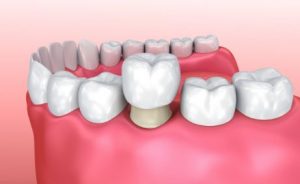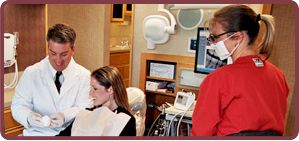 If you’ve ever had a severe cavity or broken tooth, there’s a good chance it was repaired with a dental crown. Crowns are excellent for restoring the strength, function, and appearance of natural teeth. And, while they don’t last forever, you can expect to get 10 to 15 years or more out of them when they’re properly maintained. However, one problem people experience sometimes is a crown that becomes loose or falls off. In this situation, the first thing you should do is call a dentist in Superior. Then keep reading below to find out why this happens and get tips for handling it until you can be seen.
If you’ve ever had a severe cavity or broken tooth, there’s a good chance it was repaired with a dental crown. Crowns are excellent for restoring the strength, function, and appearance of natural teeth. And, while they don’t last forever, you can expect to get 10 to 15 years or more out of them when they’re properly maintained. However, one problem people experience sometimes is a crown that becomes loose or falls off. In this situation, the first thing you should do is call a dentist in Superior. Then keep reading below to find out why this happens and get tips for handling it until you can be seen.
Why Do Dental Crowns Become Loose and Fall Out?
There are several possible reasons a dental crown becomes loose or falls out:
- Age – As mentioned, dental crowns have a certain lifespan. Like nearly all dental work, they’re subject to wear-and-tear and have to be replaced at some point. If you’ve had your crown for more than 10-15 years, it may simply be time for a replacement.
- Cavity – A dental crown itself can’t get a cavity, but the tooth structure underneath it can. If a cavity eats away at that tooth structure, it can no longer support the crown like it once did, eventually causing it to become loose or fall off.
- Clenching and grinding – Nighttime clenching and grinding put a huge amount of force on teeth and dental work. If you aren’t using a nightguard, the chronic pressure can eventually make dental crowns loose.
What Should You Do If Your Dental Crown Becomes Loose or Falls Out?
Unfortunately, dental crowns can easily be swallowed because they often come off while chewing. Hopefully you can keep that from happening! Then, start by putting your crown in a plastic sandwich bag to avoid losing it. Next, call a dentist to schedule the first available appointment.
If you’d like to try putting the crown back on, rinse it out (being careful not to drop it) and let it dry. Then use a small dab of dental cement from the store, denture adhesive, or toothpaste to put it back on your tooth. Don’t use any other type of adhesive or glue because it can damage your tooth and crown and ultimately make the dentist’s job harder.
Once a dentist has determined why the crown came off and evaluated the tooth underneath, they’ll either re-cement it or schedule a visit to make a new one. And if you see a dentist who offers convenient one-visit crowns, you’ll only need to come in once, instead of twice.
No one wants to deal with broken, faulty, or failing dental crowns. But, with these tips, you’ll be able to get your smile back on track in no time.
About the Author
Dr. Doug Clark, Jr. is a family dentist in Superior with more than 30 years of experience. He knows how alarming it can be when dental crowns fail and always makes every effort to save them. And when replacement is necessary, he offers convenient, high-quality one-visit crowns. If you have any questions or your dental crown is loose, you can contact Dr. Clark via his website.









